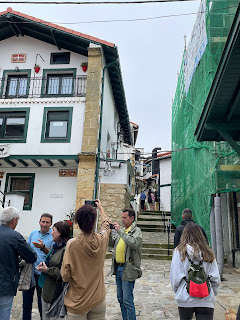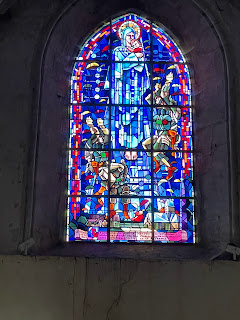I went ashore this morning intending to take a taxi to the Museum of Fine Arts in Bilbao. To my surprise when I asked the woman at the tourism desk in the cruise terminal to arrange it, she told me we aren’t really in Bilbao. Instead we’re in the little city about ten miles away called Getxo (pronounced Get-cho). So I asked if there were things to see here and when she said yes, I asked her to get me a taxi to take a tour around here. I must have an angel looking out for me because I had another fantastic day!
First a little about Getxo. It’s a city of more than 80,000 people on the northern coast of Spain in the autonomous Basque country. Like every place around here it has been settled for millennia by a variety of tribes and civilizations. It has seen a few incidents of conflict by Basque separatists who wanted to be independent of Spanish rule, but not in recent years. Until Bilbao, the industrial city next door, began to expand, Getxo was a fishing village. As Bilbao grew this place became a residential community for wealthy people and the houses around reflect that. The streets are lined with what were once mansions in Tudor, Cantabrian, and Art Deco style, but most have now been converted to apartments.
Today my driver was Francisco, a native of this area and a grandfather. He spoke no English so I spent several hours remembering and practicing my Spanish. I think I’m getting pretty good, but today was our last port in Spain so I’ll forget it again. Anyway, this is a delightful little city. Of course I sat in the front of the car and we were off to the downtown. Our first stop was the Vizcaya Bridge, a transporter bridge that crosses the Nervión River. I’ve never seen anything like it which makes sense since it’s the only working one in the world. It is a shuttle bridge which has a sort of platform at river level suspended from a high bridge structure which shuttles back and forth every ten minutes or so and can carry six cars and a few dozen passengers. It's really very unique and interesting to watch. It’s built of iron (of which there are many mines around this part of Spain) and steel.
 |
| There are cables hanging from the top of the bridge structure and in the photo below beyond the gates there's a platform for cars and people which is at the moment on the other side of the river. |
 |
| The pretty plaza across the street from the bridge |
We left downtown and traveled through beautiful residential streets with these large homes, which as I said have been divided into apartments. Francisco told me the same thing José did yesterday; Spaniards buy rather than rent their homes. I didn’t try to delve into how they do that. I think talking about mortgages would really challenge my language skills. We parked next at the waterfront and took an elevator up to the old town. This place was a fishing village and at the top of the elevator we were at the midpoint of the old town. It was charming there with stuccoed houses with red tile roofs and twisty cobblestone streets. It’s Saturday and a holiday weekend to boot, so locals were out in full force. There were lots of little restaurants and pintxos (those are tapas in Basque country) bars. I asked Francisco to pick one where we could have something to eat and drink. The place we settled on had a line waiting for a table outside, but inside the tiny kitchen there were a couple of empty bar stools which we took. Francisco ordered four different pintxos and some wonderful dry white wine. I’m not sure exactly what I ate but it was all delicious. I know I had some roasted octopus, anchovies which were not at all like the ones we get in jars, and some kind of salad which might have had tuna. The best was a piece of bread with Iberico ham, a piece of goat cheese, topped with I think fig jam and candied walnuts. It was to die for.
 |
| The elevator to go up to the old town |
 |
| Little narrow and twisting cobblestone streets up there |
 |
| Signs for different pintxos in the little bar. I was sitting at the counter |
 |
| The open room I was standing in was where the fishermen would meet before going out to talk about who would fish where and afterwards to meet and talk about how their day was and compare notes. |
We finished up and rode the elevator back down and took off. There’s a path that goes along the waterfront for walkers and bikes but no cars are allowed. We drove along above the path through old and new neighborhoods to the headland. Along the way we stopped to see the only windmill in this part of Spain. It’s not a modern windmill; it’s the kind that was used to grind wheat and corn. Think Don Quixote and La Mancha. There are the remnants of a fort, of course. There was another on the opposite side of the estuary to keep marauders from raiding.
 |
| This and the next picture are remnants of one of the old forts guarding the entrance to the harbor |
 |
| I guess I'm Sancho Panza. Where's Don Quixote? |
After a few hours it was time to get back to the ship. It was a pleasure meeting and spending a few hours with Francisco. I think we both learned something, me perhaps more than him.
Now I’m almost embarrassed to say we played Trivia again. They are doing it at 4:30 on these port days. Our team, Abandon Ship, won for the 4th straight day. The stars must have all come into alignment because we didn’t miss a single question.
Tonight we were supposed to have a dance party out by the pool, but it was moved inside because it’s cold. Who knew that there are actually dancers on board and for the first time I’ve gotten up and danced. It felt wonderful and I shall keep it up. During dinner the captain announced that our port call in Hendaye, France was canceled. It seems it is a tender port and the French port authorities said the seas would be too rough to tender. (I’m a little suspicious of that because Monday is a holiday and I think they just didn’t want to work tomorrow.) No matter. We’re spending an extra night here in Getxo.
Alright, I think it’s time to say buenas noches. So hasta mañana









































